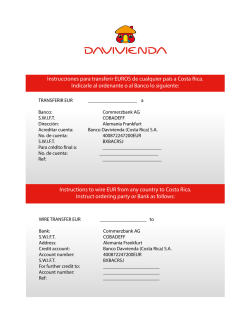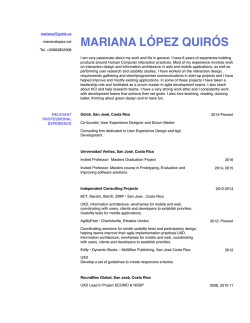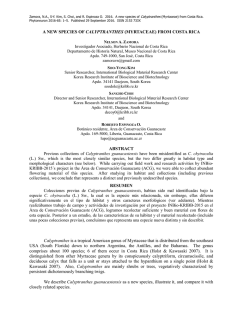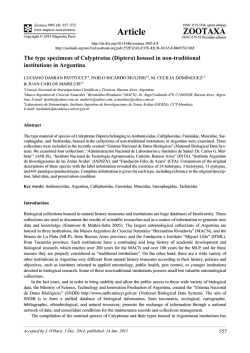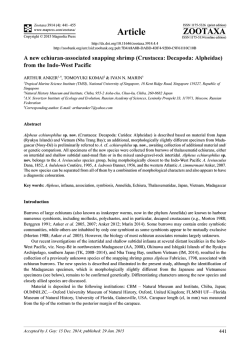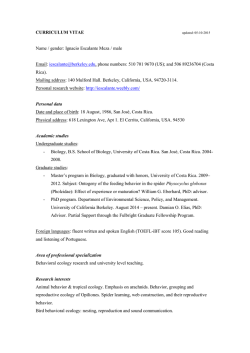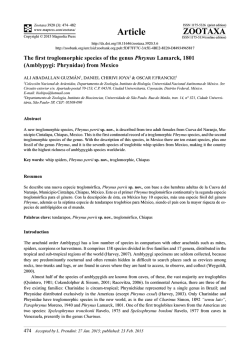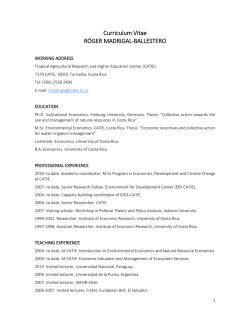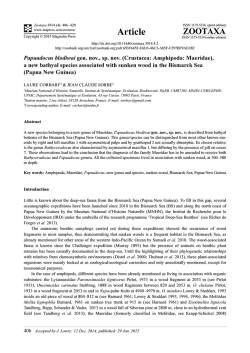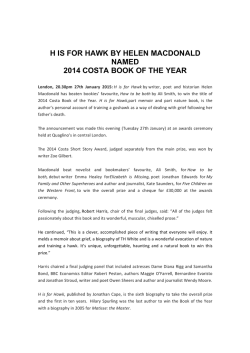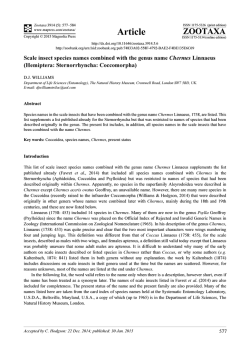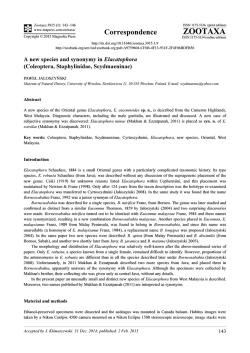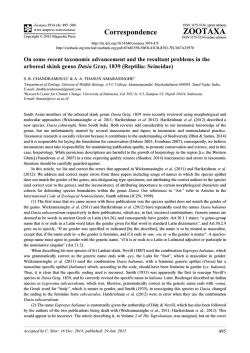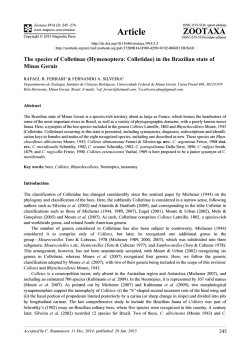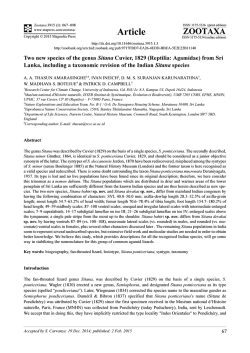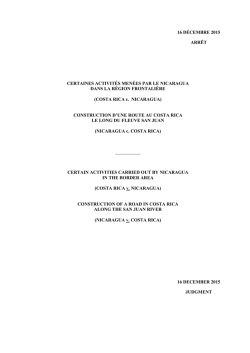
Preview - Magnolia Press
Zootaxa 3914 (5): 525–540 www.mapress.com /zootaxa / Copyright © 2015 Magnolia Press Article ISSN 1175-5326 (print edition) ZOOTAXA ISSN 1175-5334 (online edition) http://dx.doi.org/10.11646/zootaxa.3914.5.2 http://zoobank.org/urn:lsid:zoobank.org:pub:623E7F1A-2866-44BB-8B67-69971D8054C6 Mesoconius Enderlein (Diptera, Micropezidae, Taeniapterinae) of Central America S.A. MARSHALL School of Environmental Sciences, University of Guelph, Guelph, Ontario, Canada N1G 2W1 Abstract Mesoconius Enderlein, including Zelatractodes Enderlein new synonym, is revised for Central America with one described species (Mesoconius hemithorax Frey) and five new species (M. bicolor, M. dianthus, M. nigrihumeralis, M. tigrinus, and M. zadbi). The relatively large species of this entirely Neotropical genus, most of which are restricted to narrow high elevation ranges, lack the male genital fork that characterizes all other Taeniapterinae. Key words: new species, Central America, Costa Rica, cloud forest, Zelatractodes, new generic synonym Introduction The relatively large (often over 15 mm) micropezid flies in the Neotropical genera Mesoconius Enderlein and Zelatractodes Enderlein form a distinctive clade characterized by loss of the genital fork, which is a large twoarmed process arising posteromedially on the male sternite 5 of all other Taeniapterinae and Eurybatinae. Most species previously included in the genus Mesoconius are further characterized by a strongly swollen, apically pointed or nipple-like katatergite. Taeniapterine species with neither a genital fork nor a swollen katatergite have been treated as Zelatractodes, a paraphyletic group relative to the derived Mesoconius lineage characterized by the swollen katatergite. Because Zelatractodes was characterized by the plesiomorphic lack of a swollen katatergite, and because the katatergite can show a continuous range of character states from almost flat to strongly swollen, Zelatractodes and Mesoconius are here treated as synonyms. Both genera were described in the same paper (Enderlein 1922) and therefore are simultaneously published. Mesoconius is here chosen as the senior synonym because it is the more descriptive of the two available names, because it has been in more widespread use, and because it has an easily recognizable type species. Almost all members of this group are characteristic of higher elevation Neotropical forests, and several species seem to have highly restricted ranges corresponding with the fragmented nature of high altitude forests. Most species of Mesoconius are rare in collections and many are currently known from only one or a few specimens, although several are locally abundant at restricted high elevation sites. Mesoconius as here defined is an easily recognizable and clearly monophyletic group including 23 previously described species treated by Steyskal (1968) as Mesoconius (12 species) and Zelatractodes (11 species). Only one species, M. hemithorax Frey, was originally described from Central America (from Panama), with the other 22 named species and an additional 20 unnamed species occurring in the Andes (Marshall, unpublished data). Marshall (2010) suggested that "probably five described and two undescribed species occur in Costa Rica" but now that types of all species in the genus have been examined it is clear that M. hemithorax is the only previously described Mesoconius found in Central America. Five new Central American species, all of which are currently known only from Costa Rica, are described here. The Central American species are treated here separately from a larger revision of the entire genus because the Costa Rican fauna is relatively well sampled, and because there is an immediate need to provide names for flies collected during ongoing survey work at Zurquí de Moravia and elsewhere in Costa Rica. Since there are no species held in common between the South American and the Central American Mesoconius faunas it is practical to review and key these distinct faunas in separate papers. Accepted by S. Gaimari: 24 Dec. 2014; published: 30 Jan. 2015 525 vertical, shining face. Katatergite very prominent, with a tapered microtrichose apex. Vertical row of katepisternal bristles yellow. Coxae with anteroventral golden bristles. Abdomen: Syntergite 1+2 very narrow basally, constriction between syntergites about half as wide as base of T3; length of T1+2 double length of T3. Female abdomen: Pleuron dark on dorsal half of segments 2–5, otherwise pale. Oviscape reddish brown, paler apically. Bursa copulatrix large, ventral receptacle small. Single spermatheca small, slightly broader than duct; paired spermathecal duct similar in diameter to paired duct but longer and divided into a broad striate distal half and a narrower smooth distal half, distally dividing into long spermathecal bases each with a subbasal elongate oval swelling and a distal sinuate section with 2–3 deep S–bends. Paired spermathecae elongate, distinctly striate, tapered basally. Type material (all INBC): Holotype (♀): COSTA RICA. Cartago, Rio Macho forest reserve, La Esperanza del Guarco, end of Esperanza road, 2400 m. 1–2.vi.1998, S.A. Marshall. Paratypes: COSTA RICA. Cartago, Paraíso, PN Tapantí, Macizo de la Muerte, 1500 m. 19.v.2000, malaise, C. Hanson, D. Rubi (1 ♀). San José, Moravia, Zurquí de Moravia, tower path, 1600 m. 24–31.v.2013, Malaise, project ZADBI (1 ♀). Etymology. The specific name refers to Project ZADBI, the Zurquí All Diptera Biodiversity Inventory. Mesoconius zadbi and most of the other Mesoconius species newly described here are described partly on the basis of specimens from Project ZADBI. Comments. Although this species remains known only from males, M. zadbi clearly belongs in Mesoconius and can be placed in a clade characterized by a paired spermathecal duct with a striate basal half and a smooth distal half. This species is similar to the South American Mesoconius infestus group, but differs most obviously by its black mid and hind femora with contrasting orange apices. M. zadbi is probably most closely related to M. bicolor, but characters of the as yet unknown males are needed to test that hypothesis. Acknowledgments Manuel Zumbado (INBC) is acknowledged for help with logistics and permits for research in Costa Rica, and for the loan of specimens. Gunilla Ståhls (MZHF) is thanked for the loan of Frey types. Sarah Schorno and Jack Robertson are thanked for help with some of the head and thorax photographs. NSERC is gratefully acknowledged for support of the author’s work on acalyptrate taxonomy. Literature cited Cresson, E.T. Jr. (1930) Notes on and descriptions of some neotropical Neriidae and Micropezidae (Diptera). Transactions of the American Entomological Society, 56, 307–362. Enderlein, G. (1922) Klassifikation der Micropeziden. Archiv für Naturgeschicthe Series A, 88 (5), 140–229. Frey, R. (1927) Zur Systematik der Diptera Haplostomata. III. Fam. Micropezidae. Notulae Entomologicae, 7, 65–76. Hennig, W. (1935) Revision der Tyliden (Dipt., Acalypt.). I. Teil: Die Taeniapterinae Amerikas. Stettiner Entomologische Zeitung, 96, 27–67. Marshall, S.A. (2010) Micropezidae. Chapter 55. In: Brown, B.V., Borkent, A., Cumming, J.M. Wood, D.M., Woodley, N.E. & Zumbado, M.A. (Eds.), Manual of Central American Diptera. Vol. 2. NRC Research Press, Ottawa, pp. 805–813. Marshall, S.A. (2013) Grallipeza Rondani (Diptera: Micropezidae: Taeniapterinae) of the Caribbean and North America. Zootaxa, 3682 (1), 45–84. http://dx.doi.org/10.11646/zootaxa.3682.1.2 Steyskal, G.C. (1968) Family Micropezidae. In: A Catalog of the Diptera of the Americas South of the United States. Vol. 48. Departamento de Zoologia, Secretaria da Agricultura, São Paulo, pp. 1–33. 540 · Zootaxa 3914 (5) © 2015 Magnolia Press MARSHALL
© Copyright 2025

